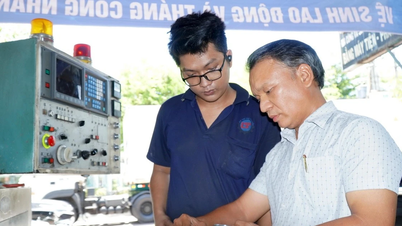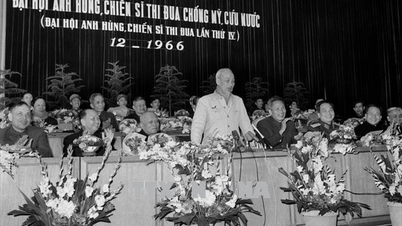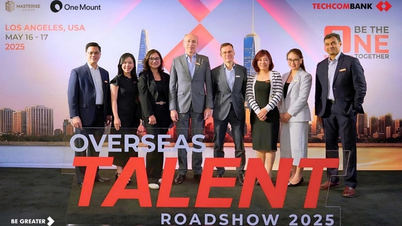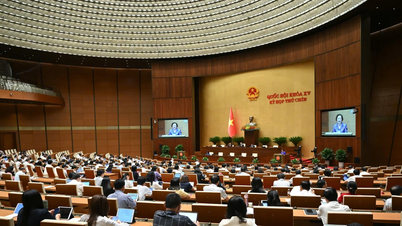Overcoming all difficulties, Vietnam has still achieved outstanding and historic achievements in socio -economic development, raising the country's position and prestige, creating new opportunities, new opportunities, and new advantages to transform itself according to the goals set by the 13th Party Congress: By 2030, becoming a developing country with modern industry and high average income, and by 2045, becoming a developed country with high income.
 |
| Hanoi capital. (Photo DUY LINH) |
Three "gates" to become a dragon
At the Policy Dialogue on Vietnam's 30 Years of Development: Looking Back at the Past and Responding to New Challenges organized by the National Economics University in collaboration with the National Institute for Policy Studies of Japan, Professor, Dr. Pham Hong Chuong, President of the National Economics University, commented: Over the past three decades, Vietnam has strongly transformed from a centrally planned economy to a market-oriented economy with high openness and export orientation, transforming from a low-income economy based on agriculture to a middle-income economy.
Building on this success, the Party and Government have set a target of turning the country into an upper-middle-income developing country by 2030 and a high-income developed country by 2045. To achieve this goal, the economy will have to grow at an average annual rate of 7% over the next 20 years.
The strong development of the 4.0 industrial revolution, digital technology, and artificial intelligence brings opportunities to improve competitiveness and economic sustainability, product quality, services, and production processes, but at the same time, it also poses many great challenges. These include increased unemployment; political, social, and institutional challenges; infrastructure issues; greater risks to information safety and security; and risks of competition and falling behind...
According to the general assessment of many economic researchers, the growth that Vietnam has achieved in recent times is largely due to the impact of timely liberalization, geographical advantages, rich resources, abundant labor, etc. Looking back at the journey of more than 30 years of Vietnam's Renovation, Professor, Dr. Ngo Thang Loi, National Economics University, commented that the economy has overcome two major "barriers". That is ensuring food security; overcoming the low-middle income level and building the foundation for an industrialized country. However, Vietnam has not yet overcome the third "barrier" of becoming an industrialized country by 2020.
Professor Tran Van Tho (Waseda University, Japan) also stated that the reason why Vietnam has not had a period of high development (average growth of 10%/year continuously for more than 10 years) is because the industrial sector is not strong enough to lead to a strong shift, the level of industrialization of the economy is relatively low compared to East Asian countries in the same golden population period.
These limitations were pointed out by the professor, in addition to reviewing the great achievements Vietnam has made in the past 30 years, such as success in economic restructuring, attracting foreign investment, successful trade policies, and the rise of a number of highly competitive enterprises such as VinGroup, Viettel, FPT, etc.
Fast growth with quality
According to economic experts, the period from 2024 to 2030 is the decisive period for Vietnam to transform itself in the spirit of the Socio-Economic Development Strategy for the period 2021-2030, continuing to grow rapidly and sustainably, gradually entering the group of high-income countries. This is an important milestone and opens up many development opportunities for our country's economy, especially under the impact of globalization, international economic integration and the 4.0 industrial revolution.
To avoid falling into the middle-income trap, Vietnam needs strategic directions and specific actions right now to maintain a rapid and sustainable growth rate and become a high-income country in the future.
Professor, Dr. Ngo Thang Loi said that to achieve the set goals, Vietnam cannot but grow rapidly but must be associated with quality growth. This requires a harmonious development model to have the best impacts from growth for social progress. The solution for the road ahead of the Vietnamese economy is to prioritize promoting growth for dynamic regions and connecting dynamic economic regions with other regions, especially slow-growing regions, so that they can directly participate in the income generation process.
The rapid growth process also cannot be achieved without the contribution of the business sector. Therefore, it is necessary to promote stronger businesses through solutions to create a level playing field for all three types of businesses, including state-owned enterprises, private enterprises and foreign-invested enterprises.
In particular, more attention should be paid to policies for the private sector, promoting the role of “leading crane” enterprises. World experience shows that countries can reach middle-income levels through liberalization, privatization and international integration, but to reach higher income levels, policies are required to stimulate the dynamism of the private sector.
Meanwhile, Professor Tran Van Tho recommended that Vietnam should develop and implement five policies to become a high-income country. These include promoting structural transformation to increase productivity; formalizing the informal sector, increasing the size of enterprises to promote capital accumulation; reforming and developing the market for production factors to allocate resources more effectively; providing skilled labor and encouraging research and development activities to promote structural transformation; and enhancing innovation capacity.
Emphasizing the need to increase productivity, Professor Tran Van Tho said that increasing productivity requires the guidance of technology and institutional reform. The advantage of the Vietnamese economy in terms of cheap labor will end, the key to escaping the middle-income trap is to continuously increase labor productivity. In the next decade, expanding industrialization, shifting industrial structure and institutional reform to allocate resources efficiently are factors that will increase productivity for Vietnam. At the same time, it is necessary to prepare for the era of innovation-based growth for the 2030s and beyond.
By the end of 2023, the size of Vietnam's economy at current prices will reach about VND 10,221.8 trillion, equivalent to USD 430 billion. Gross domestic product (GDP) per capita is estimated at VND 101.9 million/person, equivalent to USD 4,284, an increase of USD 160 compared to 2022. Regarding the economic structure in 2023, the agriculture, forestry and fishery sector accounts for 11.96%; the industry and construction sector accounts for 37.12%; the service sector accounts for 42.54%; product taxes minus product subsidies account for 8.38%.
Source: Ministry of Planning and Investment
Source: https://nhandan.vn/thoi-co-de-viet-nam-buoc-vao-nhom-cac-nuoc-thu-nhap-cao-post798166.html
Source



![[Photo] General Secretary To Lam works with Lam Dong, Binh Thuan and Dak Nong provinces](https://vphoto.vietnam.vn/thumb/1200x675/vietnam/resource/IMAGE/2025/6/11/c3e736d90cda4fe78f96c9bfb68d4e0b)

![[Photo] Third session of the Committee for Drafting Amendments and Supplements to a Number of Articles of the 2013 Constitution](https://vphoto.vietnam.vn/thumb/1200x675/vietnam/resource/IMAGE/2025/6/11/16cab51dafc741719485978eb3ed8ce3)































































































Comment (0)